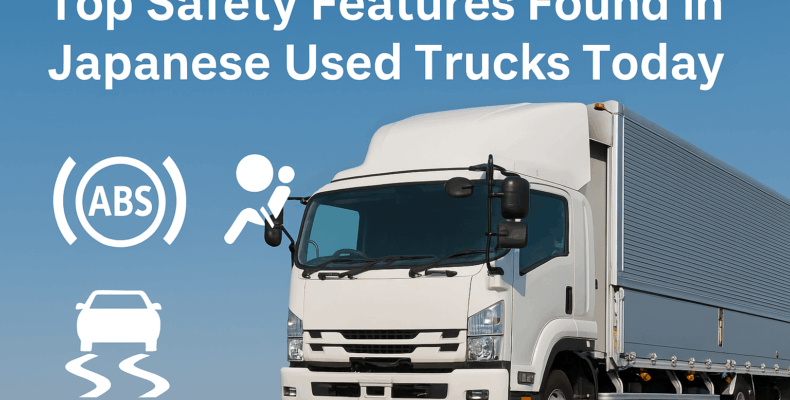When it comes to Japanese used trucks, reliability and performance are just part of the story. In recent years, Japanese truck makers have made major strides in safety technology, making their vehicles some of the safest on the road.
Whether you’re importing a Hino Dutro, Isuzu Elf, Mitsubishi Fuso Canter, or Nissan Atlas, knowing which safety features to expect helps you choose wisely and protect your investment—and your drivers.
Let’s explore the top safety features that are commonly found in today’s Japanese trucks and why they matter for both personal and commercial users.
🛡️ Why Safety Matters for Global Buyers
Accidents can cost you time, money, and even lives. However, Japanese trucks are engineered to reduce these risks with advanced features. Additionally, many countries now require imported trucks to meet specific safety standards, making this knowledge essential before buying.
Beyond that, safety features also lower insurance costs, boost resale value, and provide peace of mind—especially when transporting valuable cargo or operating in busy environments.
✅ Top Standard Safety Features in Japanese Trucks
1. Anti-lock Braking System (ABS)
ABS prevents wheels from locking during sudden braking. This helps the driver maintain control and avoid skidding, especially in wet or slippery conditions.
-
Standard in most trucks from 2005 onward
-
Reduces stopping distance on unstable roads
-
Works well with air brake systems used in heavy vehicles
2. Driver and Passenger Airbags
Airbags reduce injury in the event of a crash. Though more common in passenger vehicles, newer commercial trucks also include this feature.
-
Front airbags standard in many trucks from 2010 onward
-
Helps meet international safety inspection requirements
-
Reduces liability in commercial use cases
3. Electronic Stability Control (ESC)
ESC helps prevent rollovers and loss of control by applying brakes to individual wheels during sharp turns or skids.
-
Especially useful for high-center-of-gravity vehicles
-
Helps in mountainous or high-wind regions
-
Required in some countries for trucks over a certain weight
4. Rearview Camera and Parking Sensors
These features assist in maneuvering and prevent accidents when reversing, especially in tight urban areas.
-
Found on most post-2012 models
-
Improves safety in loading docks and warehouses
-
Helps meet workplace safety standards
5. Lane Departure Warning System (LDWS)
LDWS alerts the driver if the truck starts to drift from its lane without signaling.
-
Available in newer Japanese trucks, especially from 2018 onward
-
Uses camera sensors for real-time monitoring
-
Reduces highway accidents and fatigue-related errors
6. Collision Mitigation Braking System (CMBS)
This advanced system automatically applies brakes if the truck detects a likely collision.
-
Featured in trucks like the Mitsubishi Fuso Super Great
-
Reduces impact severity or prevents accidents entirely
-
Often bundled with adaptive cruise control
7. Traction Control System (TCS)
TCS limits wheel spin on slippery roads by adjusting engine power or applying brakes.
-
Enhances grip during rain, snow, or dirt-road driving
-
Reduces driver fatigue in off-road conditions
-
Works well with ABS and ESC
🧰 Bonus Safety Features in Premium Models
-
Blind Spot Monitoring (BSM)
-
Forward Collision Warning (FCW)
-
Hill Start Assist (HSA)
-
Driver Alert Systems (DAS)
These are especially helpful for long-haul or high-frequency transport businesses.
🚛 Choosing the Right Truck with Safety in Mind
Before you buy, ask your exporter about:
-
Year of manufacture and available safety systems
-
Maintenance history, especially on braking and stability systems
-
Whether retrofits or upgrades are available for export
Some safety features may differ depending on the domestic market grade in Japan, so always request photos or inspection certificates before shipping.
👉 To avoid risks, start with exporters you can trust:
Top 5 Trusted Japanese Used Truck Exporters for Global Buyers
These companies offer verified vehicles, full documentation, and pre-shipment inspections.
✅ Final Thoughts
When importing a Japanese truck, safety should be one of your top priorities. Thanks to Japan’s strict manufacturing and inspection standards, many trucks already come with advanced protection systems. From ABS to collision mitigation, these features make every trip safer.
So, take the time to understand what’s built into your truck—and choose models that keep your drivers, cargo, and business protected.
